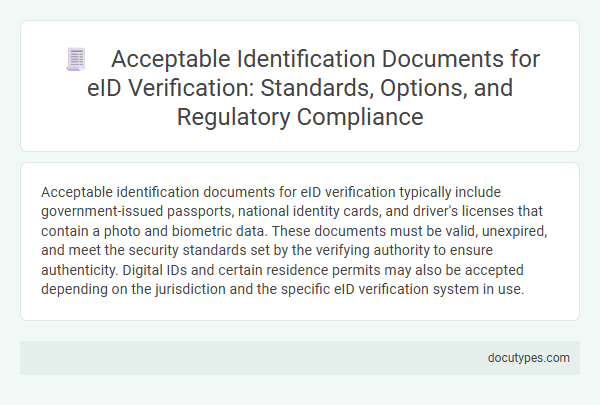Acceptable identification documents for eID verification typically include government-issued passports, national identity cards, and driver's licenses that contain a photo and biometric data. These documents must be valid, unexpired, and meet the security standards set by the verifying authority to ensure authenticity. Digital IDs and certain residence permits may also be accepted depending on the jurisdiction and the specific eID verification system in use.
Introduction to eID Verification and Its Importance
eID verification is a secure process that confirms your identity using electronic identification documents. It plays a crucial role in enhancing security and streamlining access to digital services.
- Government-issued IDs - Official documents like passports and national ID cards are the most trusted for eID verification.
- Driver's Licenses - Recognized and widely accepted for confirming identity in many verification systems.
- Residence Permits - Valid permits issued by authorities serve as proof of identity and residency status.
Regulatory Requirements for Identification Documents
Regulatory requirements for identification documents emphasize the need for government-issued IDs that include a photograph and unique personal information. Acceptable documents often include passports, national ID cards, and driver's licenses compliant with international standards.
Your eID verification process must comply with legal frameworks such as AML (Anti-Money Laundering) and KYC (Know Your Customer) regulations. These regulations mandate that identification documents be current, unexpired, and verifiable through authoritative databases. Ensuring your documents meet these standards helps guarantee secure and legitimate identity verification.
Core Standards for Acceptable ID Documents
| Core Standards for Acceptable Identification Documents | Description |
|---|---|
| Government Issued | Only official documents issued by recognized government authorities qualify for eID verification. Examples include passports, national identity cards, and driver's licenses. |
| Uniqueness and Tamper-Resistance | Documents must have secure features such as holograms, microtext, barcodes, or embedded chips to prevent forgery and duplication. |
| Validity and Expiration | Identification documents must be current and unexpired at the time of verification to be accepted. |
| Photo Identification | Documents must include a clear, recent photograph of the holder to establish visual identity during eID verification. |
| Personal Data Consistency | Name, date of birth, and other personal details on the document should match the information provided for eID registration or verification. |
| Machine Readable Zones (MRZ) | Documents featuring MRZ facilitate automated and accurate data extraction, enhancing the reliability of identity verification processes. |
Government-Issued Identification Options
Government-issued identification documents are essential for successful eID verification, providing trusted proof of identity. Acceptable documents must be current, valid, and issued by a recognized authority to ensure authenticity and compliance.
- Passport - A globally recognized travel document containing a photo and personal details used for identity verification.
- Driver's License - A state or country-issued card featuring a photograph and identification number, commonly accepted for eID verification.
- National Identity Card - An official government ID card specifically designed for national identification purposes, often equipped with security features for electronic verification.
Internationally Recognized ID Documents
Internationally recognized identification documents play a crucial role in eID verification processes by ensuring authenticity and global acceptance. Commonly accepted IDs include passports, national identity cards, and driver's licenses issued by government authorities worldwide. These documents contain standardized security features that facilitate reliable identity verification across borders.
Digital and Electronic Identity Credentials
Acceptable identification documents for eID verification include various digital and electronic identity credentials designed to securely confirm an individual's identity. These credentials enhance verification accuracy while supporting compliance with legal and security standards.
- Digital Identity Cards - Government-issued digital ID cards stored on mobile devices enable secure and convenient identity verification.
- Electronic Passports (ePassports) - Embedded with an electronic chip containing biometric information, ePassports allow for fast and reliable identity authentication.
- Mobile Driver's Licenses (mDLs) - Digitally issued driver's licenses accessible via smartphone apps provide verified identity through encrypted credentials.
Trusted digital identity credentials play a crucial role in seamless and secure eID verification processes across various platforms and services.
Special Considerations for Minors and Vulnerable Groups
Acceptable identification documents for eID verification typically include passports, national ID cards, and driver's licenses. Special considerations apply to minors and vulnerable groups to ensure their protection and compliance with legal standards.
Minors often require additional documentation such as consent forms from guardians or school-issued IDs. Vulnerable groups may need to provide supplementary proof of identity or authorization to verify their status securely.
Document Security Features and Fraud Prevention
Acceptable identification documents for eID verification typically include passports, national ID cards, and driver's licenses, each embedded with advanced security features such as holograms, microprinting, and embedded chips. These security elements play a crucial role in preventing fraud by making document replication and tampering significantly more difficult. Your verification process is strengthened when documents showcase these sophisticated technologies, ensuring a higher level of trust and authenticity.
Common Challenges in Document Verification
Identification documents such as passports, driver's licenses, and national ID cards are commonly accepted for eID verification. Each document must meet specific security standards to be valid for identity confirmation.
Common challenges in document verification include poor image quality and inconsistencies in data. These issues can delay the verification process and may require resubmission to ensure accuracy.
What Identification Documents Are Acceptable for eID Verification? Infographic

